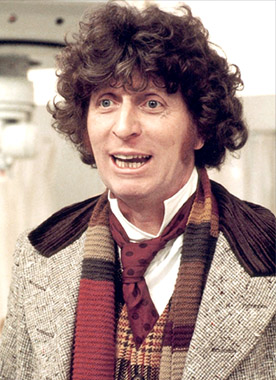Plot
Alerted to impending trouble by the TARDIS's Cloister Bell, the Fourth Doctor decides to stay out of trouble, and instead repair the TARDIS's broken chameleon circuit by materialising around a real police box on Earth and recording its exact dimensions with Adric's help. With those, he can give the mathematicians of the planet Logopolis the right block-transfer computations to repair the circuit. The Master learns of the Doctor's plan, and materialises his TARDIS around the police box first, causing a recursion loop with the Doctor's. The Doctor eventually breaks his TARDIS out of the loop, but when they step outside, he sees a figure in white, the Watcher, telling him to go to Logopolis immediately. En route, they find they have gained a passenger, Tegan Jovanka, an airline stewardess who entered the Police box seeking help for a broken-down car.
At Logopolis, everything seems normal as the Doctor provides the Monitor, the lead mathematician, his measurements to give to the others and perform their verbal calculations. They soon discover that the Master had arrived first, with several of the mathematicians killed by his tissue-compression eliminator. The Master's TARDIS materialises, and he and Nyssa, under his hypnotic control, seize the control center and use a device to silence the other mathematicians, demanding the Monitor to explain the purpose of a radio telescope on the planet. The Monitor begs for the Master to stop the silencing device. The Master does so, but to the Monitor's horror, the mathematicians remain silent, and they find the planet starting to turn to dust. The Monitor quickly explains that their calculations were used to power Charged Vacuum Emboitments (CVEs) which were used to funnel off excess entropy from this universe to prevent its approaching heat death; without the CVEs, entropy is taking over. The Monitor urges the Doctor to use their program to create a fully stable CVE, before he disintegrates. The Doctor and Master agree to work together and, after releasing Nyssa, bring Tegan with them to the Master's TARDIS and depart for Earth. Adric and Nyssa try to follow in the Doctor's TARDIS, but initially end up far outside the universe, and watch as entropy obliterates the sector of space with Nyssa's home planet, Traken. However, they fix the controls to track and follow the Master's TARDIS to Earth.

On Earth, the Doctor and Master use the radio telescope of the Pharos Project – from which the Logopolitans modelled theirs – to send the program, while the Doctor's companions help to waylay the project's guards. However, the Master holds the Doctor hostage with his tissue compression eliminator and broadcasts a message across space, threatening to destroy the CVE and render the heat death process completely unstoppable, effectively blackmailing the rest of the universe to submit to him. The Doctor quickly runs out onto the telescope's gantry to disconnect the power cable, which will prevent the Master from destroying the CVE, but the Master in turn tilts the dish downwards. Left with only the cable supporting him, the Doctor tears it out of its housing, deactivating the dish, but also dropping the Doctor several hundred feet to the ground. The Master escapes in his TARDIS.
Adric, Nyssa, and Tegan gather around the mortally-injured Doctor, who has visions of his past companions and enemies. His three companions see the Watcher appear, and the Doctor explains that "It's the end... but the moment has been prepared for." The Watcher touches and merges with the Doctor, causing him to regenerate into the Fifth Doctor.








